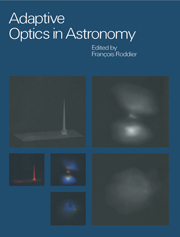Book contents
- Frontmatter
- Contents
- List of contributors
- Part one Introductory background
- Part two The design of an adaptive optics system
- Part three Adaptive optics with natural guide stars
- Part four Adaptive optics with laser beacons
- 11 Overview of adaptive optics with laser beacons
- 12 The design of laser beacon AO systems
- 13 Laser beacon adaptive optics systems
- Part five The impact of adaptive optics in astronomy
- Glossary of acronyms
- Index
13 - Laser beacon adaptive optics systems
from Part four - Adaptive optics with laser beacons
Published online by Cambridge University Press: 23 November 2009
- Frontmatter
- Contents
- List of contributors
- Part one Introductory background
- Part two The design of an adaptive optics system
- Part three Adaptive optics with natural guide stars
- Part four Adaptive optics with laser beacons
- 11 Overview of adaptive optics with laser beacons
- 12 The design of laser beacon AO systems
- 13 Laser beacon adaptive optics systems
- Part five The impact of adaptive optics in astronomy
- Glossary of acronyms
- Index
Summary
Introduction
This chapter presents an overview of laser guide star (LGS) AO systems which are in operation now or are under development. We will see that the systems encompass a wide range of technologies and implementation approaches. Some are built from well-tested components. Others explore new territory in terms of concepts and hardware, and are aimed at optimizing LGS AO for astronomy. As discussed in Chapter 11, one system (at the SOR 1.5-m telescope) has been operational for several years. Although it was developed for defense applications, the SOR system has been made available for astronomers to gain experience using LGS AO.
LGS AO systems are listed in Table 13.1. Included are those which exist or are under development and planned to be in operation by the year 2000. The table gives the telescope and the organization developing AO, along with: the diameter of the telescope; the number of DM actuators over the telescope pupil; the type of LGS (Rayleigh or sodium) and laser power; and the date of AO first light.
The remainder of this chapter briefly summarizes the systems in Table 13.1, emphasizing special features of each. For more detailed discussions, the reader is referred to technical papers on the systems in the proceedings of the 1994 Kona SPIE conference on AO (SPIE 1994), the 1995 Garching ESO/OSA (Garching 1995) and SPIE (SPIE 1995) conferences on AO, the 1996 OSA (OSA 1996) conference, and the 1998 SPIE and ESO/OSA meetings.
- Type
- Chapter
- Information
- Adaptive Optics in Astronomy , pp. 331 - 348Publisher: Cambridge University PressPrint publication year: 1999

